The Cambridge History of Japan, Vol. 4: Early Modern Japan
Подождите немного. Документ загружается.

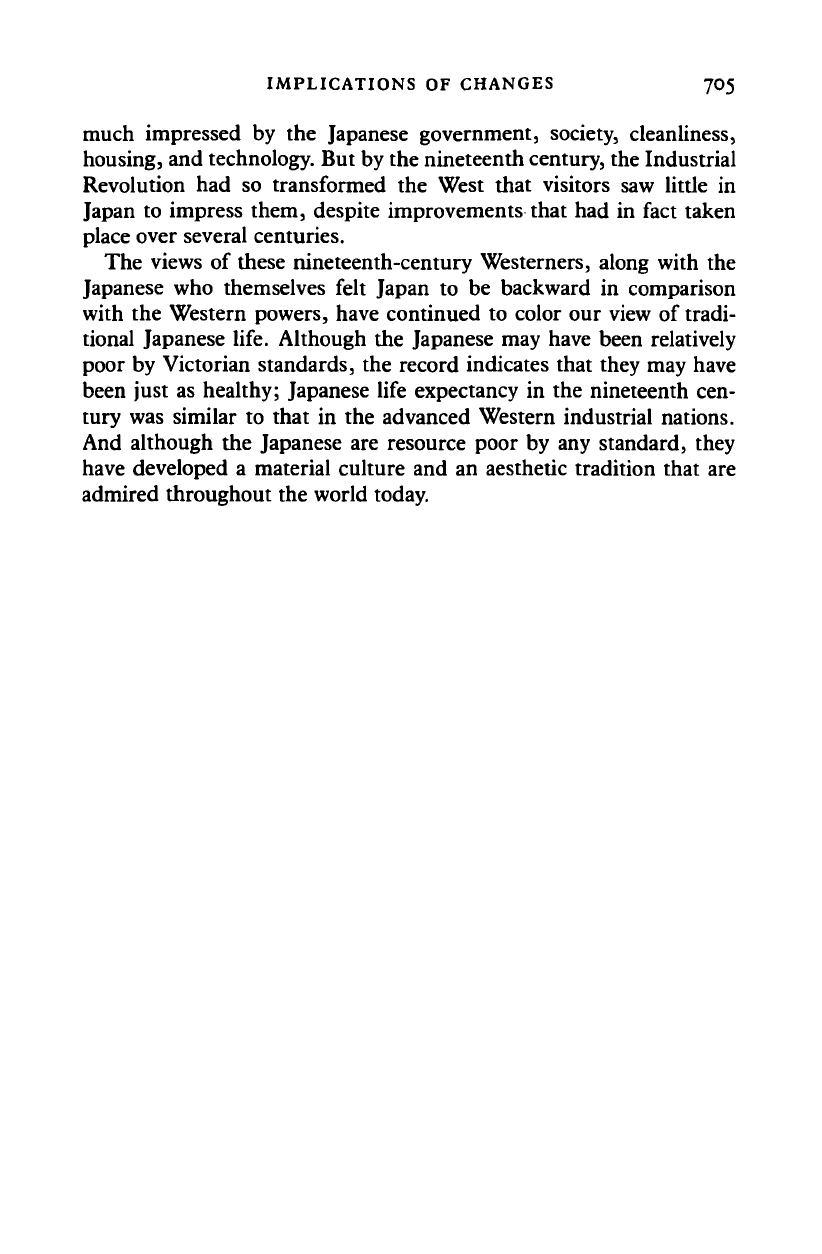
IMPLICATIONS OF CHANGES 705
much impressed by the Japanese government, society, cleanliness,
housing, and technology. But by the nineteenth century, the Industrial
Revolution had so transformed the West that visitors saw little in
Japan to impress them, despite improvements that had in fact taken
place over several centuries.
The views of these nineteenth-century Westerners, along with the
Japanese who themselves felt Japan to be backward in comparison
with the Western powers, have continued to color our view of tradi-
tional Japanese life. Although the Japanese may have been relatively
poor by Victorian standards, the record indicates that they may have
been just as healthy; Japanese life expectancy in the nineteenth cen-
tury was similar to that in the advanced Western industrial nations.
And although the Japanese are resource poor by any standard, they
have developed a material culture and an aesthetic tradition that are
admired throughout the world today.
Cambridge Histories Online © Cambridge University Press, 2008
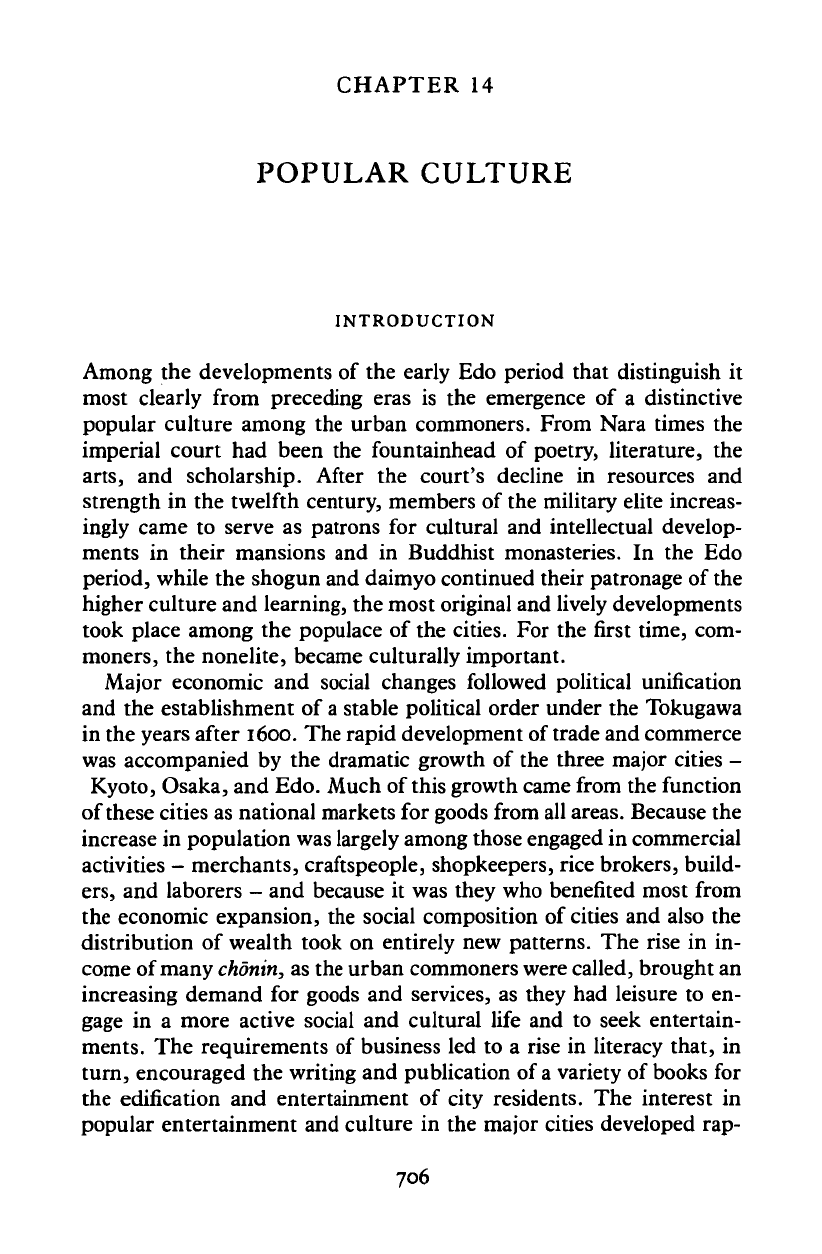
CHAPTER 14
POPULAR CULTURE
INTRODUCTION
Among the developments of the early Edo period that distinguish it
most clearly from preceding eras is the emergence of a distinctive
popular culture among the urban commoners. From Nara times the
imperial court had been the fountainhead of poetry, literature, the
arts,
and scholarship. After the court's decline in resources and
strength in the twelfth century, members of the military elite increas-
ingly came to serve as patrons for cultural and intellectual develop-
ments in their mansions and in Buddhist monasteries. In the Edo
period, while the shogun and daimyo continued their patronage of the
higher culture and learning, the most original and lively developments
took place among the populace of the cities. For the first time, com-
moners, the nonelite, became culturally important.
Major economic and social changes followed political unification
and the establishment of
a
stable political order under the Tokugawa
in the years after 1600. The rapid development of trade and commerce
was accompanied by the dramatic growth of the three major cities -
Kyoto, Osaka, and Edo. Much of
this
growth came from the function
of these cities as national markets for goods from all areas. Because the
increase in population was largely among those engaged in commercial
activities - merchants, craftspeople, shopkeepers, rice brokers, build-
ers,
and laborers - and because it was they who benefited most from
the economic expansion, the social composition of cities and also the
distribution of wealth took on entirely new patterns. The rise in in-
come of many
chonin,
as the urban commoners were called, brought an
increasing demand for goods and services, as they had leisure to en-
gage in a more active social and cultural life and to seek entertain-
ments. The requirements of business led to a rise in literacy that, in
turn, encouraged the writing and publication of
a
variety of books for
the edification and entertainment of city residents. The interest in
popular entertainment and culture in the major cities developed rap-
706
Cambridge Histories Online © Cambridge University Press, 2008
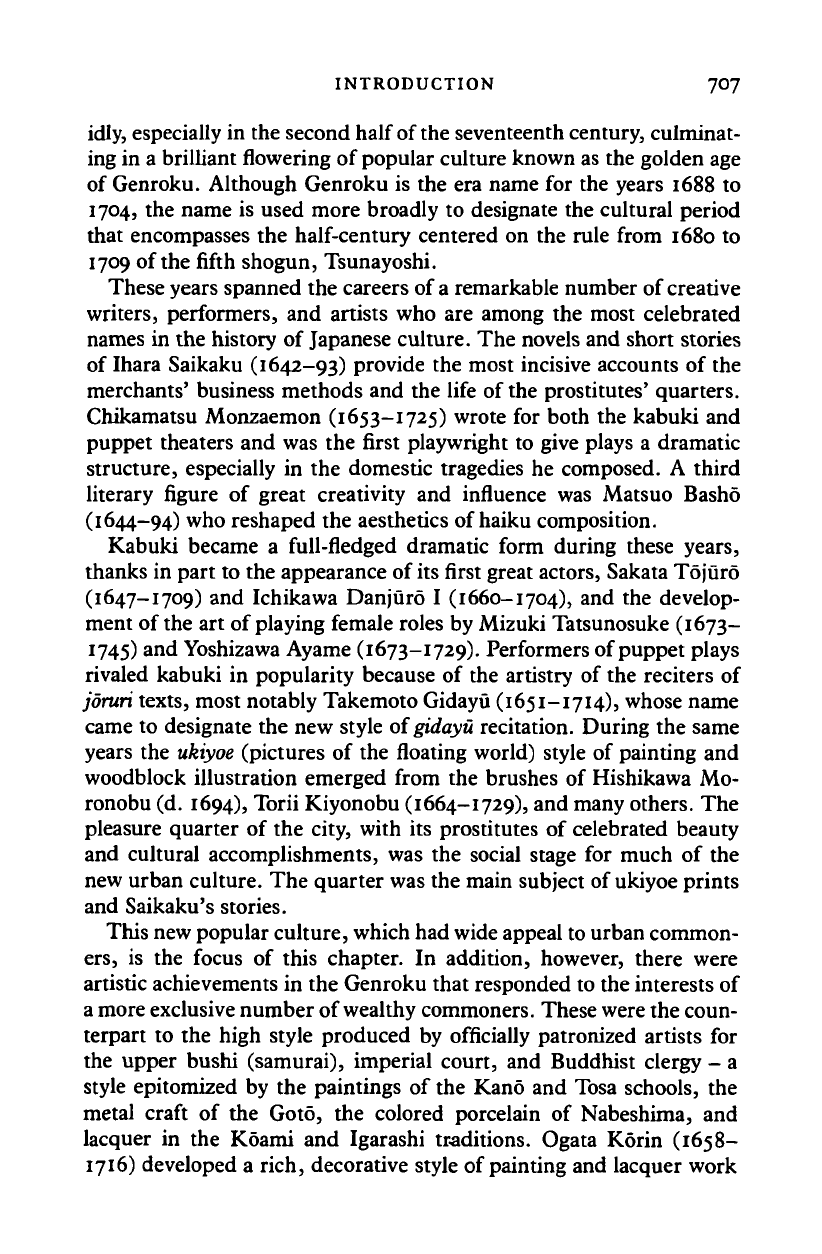
INTRODUCTION 707
idly, especially in the second half of
the
seventeenth century, culminat-
ing in a brilliant flowering of popular culture known as the golden age
of Genroku. Although Genroku is the era name for the years 1688 to
1704,
the name is used more broadly to designate the cultural period
that encompasses the half-century centered on the rule from 1680 to
1709 of the fifth shogun, Tsunayoshi.
These years spanned the careers of
a
remarkable number of creative
writers, performers, and artists who are among the most celebrated
names in the history of Japanese culture. The novels and short stories
of Ihara Saikaku (1642-93) provide the most incisive accounts of the
merchants' business methods and the life of the prostitutes' quarters.
Chikamatsu Monzaemon (1653-1725) wrote for both the kabuki and
puppet theaters and was the first playwright to give plays a dramatic
structure, especially in the domestic tragedies he composed. A third
literary figure of great creativity and influence was Matsuo Basho
(1644-94) who reshaped the aesthetics of haiku composition.
Kabuki became a full-fledged dramatic form during these years,
thanks in part to the appearance of
its
first great actors, Sakata Tojuro
(1647-1709) and Ichikawa Danjuro I (1660-1704), and the develop-
ment of
the
art of playing female roles by Mizuki Tatsunosuke
(1673-
1745) and Yoshizawa Ayame (1673-1729). Performers of puppet plays
rivaled kabuki in popularity because of the artistry of the reciters of
jdruri
texts, most notably Takemoto Gidayu (1651-1714), whose name
came to designate the new style of
gidayu
recitation. During the same
years the
ukiyoe
(pictures of the floating world) style of painting and
woodblock illustration emerged from the brushes of Hishikawa Mo-
ronobu (d. 1694), Torii Kiyonobu (1664-1729), and many others. The
pleasure quarter of the city, with its prostitutes of celebrated beauty
and cultural accomplishments, was the social stage for much of the
new urban culture. The quarter was the main subject of ukiyoe prints
and Saikaku's stories.
This new popular culture, which had wide appeal to urban common-
ers,
is the focus of this chapter. In addition, however, there were
artistic achievements in the Genroku that responded to the interests of
a more exclusive number of wealthy commoners. These were the coun-
terpart to the high style produced by officially patronized artists for
the upper bushi (samurai), imperial court, and Buddhist clergy - a
style epitomized by the paintings of the Kano and Tosa schools, the
metal craft of the Goto, the colored porcelain of Nabeshima, and
lacquer in the Kdami and Igarashi traditions. Ogata Korin (1658-
1716) developed a rich, decorative style of painting and lacquer work
Cambridge Histories Online © Cambridge University Press, 2008
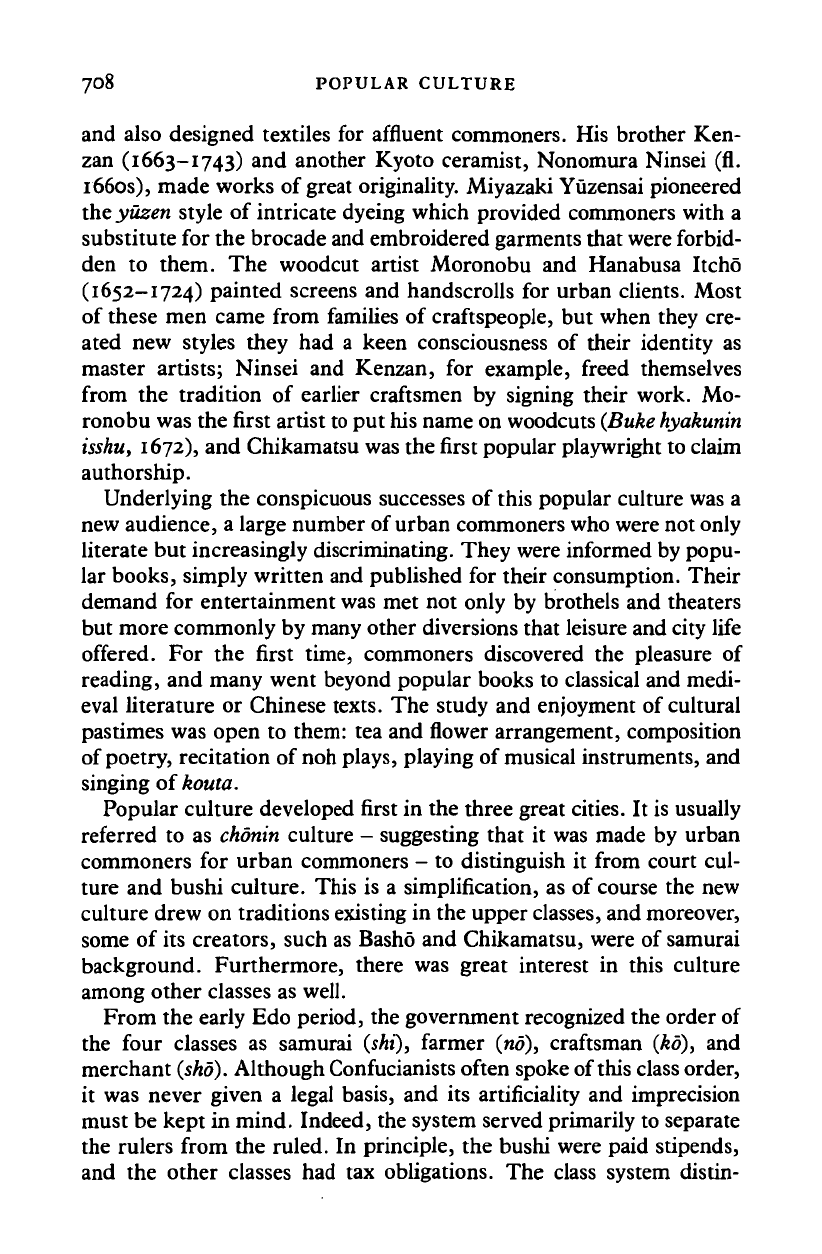
708 POPULAR CULTURE
and also designed textiles for affluent commoners. His brother Ken-
zan (1663-1743) and another Kyoto ceramist, Nonomura Ninsei (fl.
1660s),
made works of great originality. Miyazaki Yuzensai pioneered
the yuzen style of intricate dyeing which provided commoners with a
substitute for the brocade and embroidered garments that were forbid-
den to them. The woodcut artist Moronobu and Hanabusa Itcho
(1652-1724) painted screens and handscrolls for urban clients. Most
of these men came from families of craftspeople, but when they cre-
ated new styles they had a keen consciousness of their identity as
master artists; Ninsei and Kenzan, for example, freed themselves
from the tradition of earlier craftsmen by signing their work. Mo-
ronobu was the first artist to put his name on woodcuts
{Buke hyakunin
isshu, 1672), and Chikamatsu was the first popular playwright to claim
authorship.
Underlying the conspicuous successes of this popular culture was a
new audience, a large number of urban commoners who were not only
literate but increasingly discriminating. They were informed by popu-
lar books, simply written and published for their consumption. Their
demand for entertainment was met not only by brothels and theaters
but more commonly by many other diversions that leisure and city life
offered. For the first time, commoners discovered the pleasure of
reading, and many went beyond popular books to classical and medi-
eval literature or Chinese texts. The study and enjoyment of cultural
pastimes was open to them: tea and flower arrangement, composition
of
poetry,
recitation of noh plays, playing of musical instruments, and
singing of kouta.
Popular culture developed first in the three great cities. It is usually
referred to as
chonin
culture
—
suggesting that it was made by urban
commoners for urban commoners - to distinguish it from court cul-
ture and bushi culture. This is a simplification, as of course the new
culture drew on traditions existing in the upper classes, and moreover,
some of its creators, such as Basho and Chikamatsu, were of samurai
background. Furthermore, there was great interest in this culture
among other classes as well.
From the early Edo period, the government recognized the order of
the four classes as samurai
(shi),
farmer (no), craftsman (ko), and
merchant
(sho).
Although Confucianists often spoke of this class order,
it was never given a legal basis, and its artificiality and imprecision
must be kept in mind. Indeed, the system served primarily to separate
the rulers from the ruled. In principle, the bushi were paid stipends,
and the other classes had tax obligations. The class system distin-
Cambridge Histories Online © Cambridge University Press, 2008
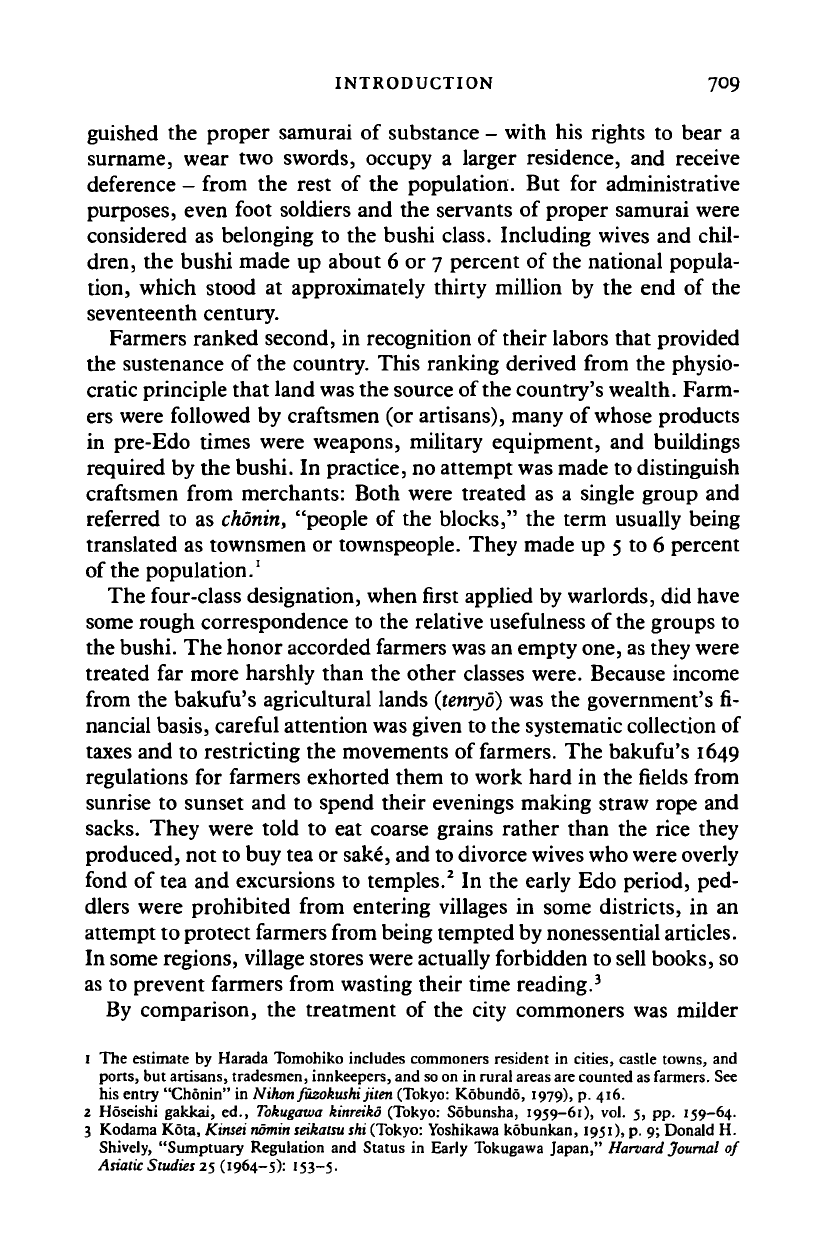
INTRODUCTION 709
guished the proper samurai of substance - with his rights to bear a
surname, wear two swords, occupy a larger residence, and receive
deference - from the rest of the population. But for administrative
purposes, even foot soldiers and the servants of proper samurai were
considered as belonging to the bushi class. Including wives and chil-
dren, the bushi made up about 6 or 7 percent of the national popula-
tion, which stood at approximately thirty million by the end of the
seventeenth century.
Farmers ranked second, in recognition of their labors that provided
the sustenance of the country. This ranking derived from the physio-
cratic principle that land was the source of
the
country's wealth. Farm-
ers were followed by craftsmen (or artisans), many of
whose
products
in pre-Edo times were weapons, military equipment, and buildings
required by the bushi. In practice, no attempt was made to distinguish
craftsmen from merchants: Both were treated as a single group and
referred to as
chdnin,
"people of the blocks," the term usually being
translated as townsmen or townspeople. They made up 5 to 6 percent
of the population.
1
The four-class designation, when first applied by warlords, did have
some rough correspondence to the relative usefulness of the groups to
the
bushi.
The honor accorded farmers was an empty one, as they were
treated far more harshly than the other classes were. Because income
from the bakufu's agricultural lands
(tenryo)
was the government's fi-
nancial basis, careful attention was given to the systematic collection of
taxes and to restricting the movements of farmers. The bakufu's 1649
regulations for farmers exhorted them to work hard in the fields from
sunrise to sunset and to spend their evenings making straw rope and
sacks.
They were told to eat coarse grains rather than the rice they
produced, not to buy tea or sake, and to divorce wives who were overly
fond of tea and excursions to temples.
2
In the early Edo period, ped-
dlers were prohibited from entering villages in some districts, in an
attempt to protect farmers from being tempted by nonessential articles.
In some regions, village stores were actually forbidden to sell books, so
as to prevent farmers from wasting their time reading.
3
By comparison, the treatment of the city commoners was milder
1 The estimate by Harada Tomohiko includes commoners resident in cities, castle towns, and
ports,
but artisans, tradesmen, innkeepers, and so on in rural areas are counted as farmers. See
his entry "Chonin" in Nihon fuzokushi jiten (Tokyo: Kobundo, 1979), p. 416.
2 Hoseishi gakkai, ed., Tokugawa kinreiko (Tokyo: Sobunsha, 1959-61), vol. 5, pp. 159-64.
3 Kodama Kota, Kinsei
nomin seikatsu shi
(Tokyo: Yoshikawa kobunkan, 1951), p. 9; Donald H.
Shively, "Sumptuary Regulation and Status in Early Tokugawa Japan," Harvard Journal of
Asiatic Studies 25 (1964-5): 153-5.
Cambridge Histories Online © Cambridge University Press, 2008
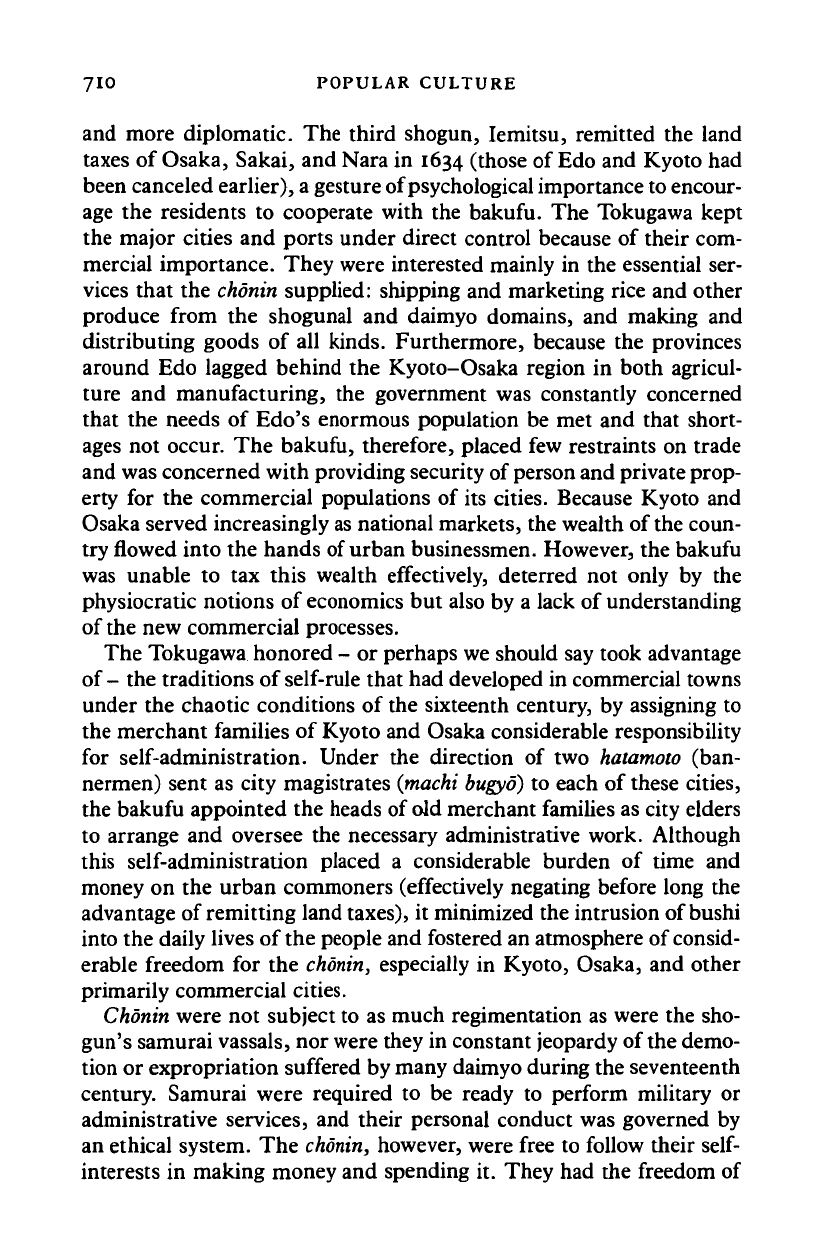
710 POPULAR CULTURE
and more diplomatic. The third shogun, Iemitsu, remitted the land
taxes of Osaka, Sakai, and Nara in 1634 (those of Edo and Kyoto had
been canceled earlier), a gesture of psychological importance to encour-
age the residents to cooperate with the bakufu. The Tokugawa kept
the major cities and ports under direct control because of their com-
mercial importance. They were interested mainly in the essential ser-
vices that the
chonin
supplied: shipping and marketing rice and other
produce from the shogunal and daimyo domains, and making and
distributing goods of all kinds. Furthermore, because the provinces
around Edo lagged behind the Kyoto-Osaka region in both agricul-
ture and manufacturing, the government was constantly concerned
that the needs of Edo's enormous population be met and that short-
ages not occur. The bakufu, therefore, placed few restraints on trade
and was concerned with providing security of person and private prop-
erty for the commercial populations of its cities. Because Kyoto and
Osaka served increasingly as national markets, the wealth of the coun-
try flowed into the hands of urban businessmen. However, the bakufu
was unable to tax this wealth effectively, deterred not only by the
physiocratic notions of economics but also by a lack of understanding
of the new commercial processes.
The Tokugawa honored - or perhaps we should say took advantage
of - the traditions of self-rule that had developed in commercial towns
under the chaotic conditions of the sixteenth century, by assigning to
the merchant families of Kyoto and Osaka considerable responsibility
for self-administration. Under the direction of two
hatamoto
(ban-
nermen) sent as city magistrates
(machi bugyo)
to each of these cities,
the bakufu appointed the heads of old merchant families as city elders
to arrange and oversee the necessary administrative work. Although
this self-administration placed a considerable burden of time and
money on the urban commoners (effectively negating before long the
advantage of remitting land taxes), it minimized the intrusion of bushi
into the daily lives of the people and fostered an atmosphere of consid-
erable freedom for the
chonin,
especially in Kyoto, Osaka, and other
primarily commercial cities.
Chonin
were not subject to as much regimentation as were the sho-
gun's samurai vassals, nor were they in constant jeopardy of the demo-
tion or expropriation suffered by many daimyo during the seventeenth
century. Samurai were required to be ready to perform military or
administrative services, and their personal conduct was governed by
an ethical system. The
chonin,
however, were free to follow their
self-
interests in making money and spending it. They had the freedom of
Cambridge Histories Online © Cambridge University Press, 2008
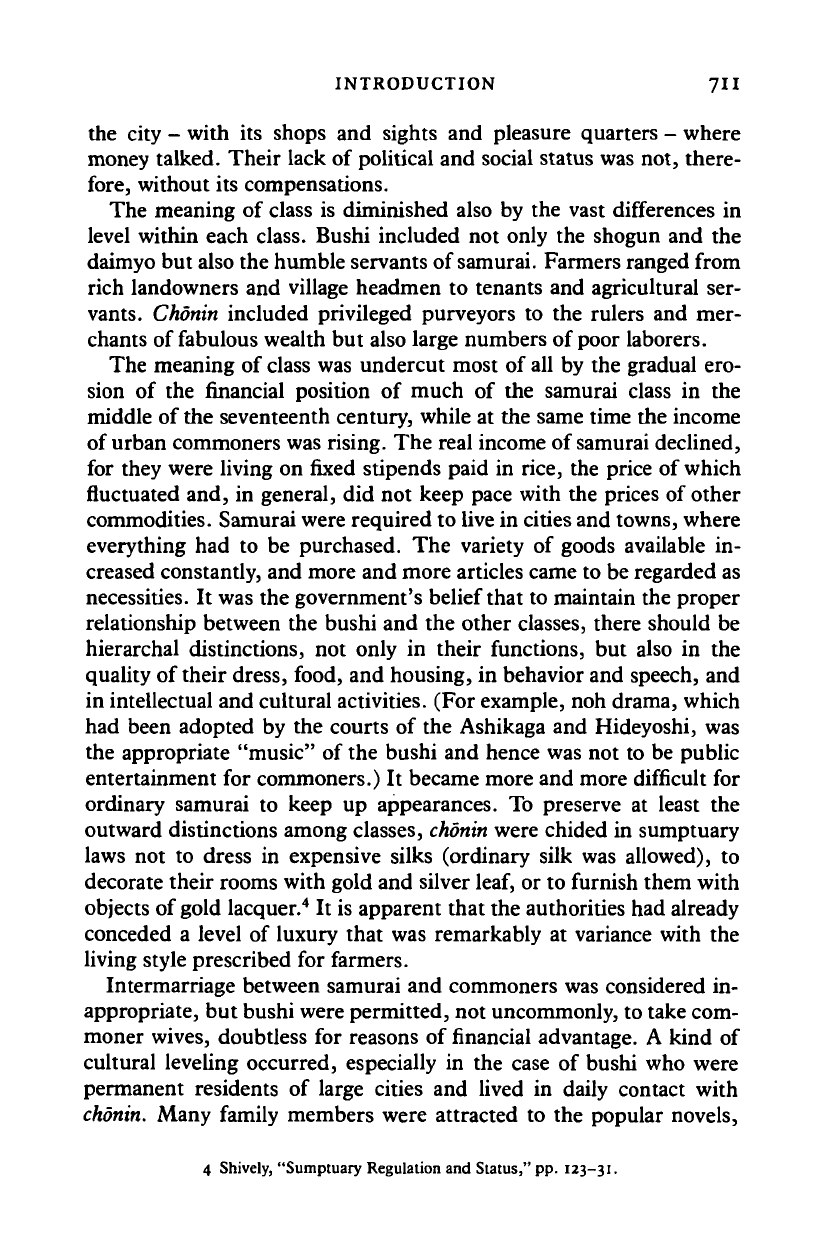
INTRODUCTION 711
the city - with its shops and sights and pleasure quarters - where
money talked. Their lack of political and social status was not, there-
fore,
without its compensations.
The meaning of class is diminished also by the vast differences in
level within each class. Bushi included not only the shogun and the
daimyo but also the humble servants of
samurai.
Farmers ranged from
rich landowners and village headmen to tenants and agricultural ser-
vants.
Chonin included privileged purveyors to the rulers and mer-
chants of fabulous wealth but also large numbers of poor laborers.
The meaning of class was undercut most of all by the gradual ero-
sion of the financial position of much of the samurai class in the
middle of the seventeenth century, while at the same time the income
of urban commoners was rising. The real income of samurai declined,
for they were living on fixed stipends paid in rice, the price of which
fluctuated and, in general, did not keep pace with the prices of other
commodities. Samurai were required to live in cities and towns, where
everything had to be purchased. The variety of goods available in-
creased constantly, and more and more articles came to be regarded as
necessities. It was the government's belief that to maintain the proper
relationship between the bushi and the other classes, there should be
hierarchal distinctions, not only in their functions, but also in the
quality of their dress, food, and housing, in behavior and speech, and
in intellectual and cultural activities. (For example, noh drama, which
had been adopted by the courts of the Ashikaga and Hideyoshi, was
the appropriate "music" of the bushi and hence was not to be public
entertainment for commoners.) It became more and more difficult for
ordinary samurai to keep up appearances. To preserve at least the
outward distinctions among classes,
chonin
were chided in sumptuary
laws not to dress in expensive silks (ordinary silk was allowed), to
decorate their rooms with gold and silver
leaf,
or to furnish them with
objects of gold lacquer.
4
It is apparent that the authorities had already
conceded a level of luxury that was remarkably at variance with the
living style prescribed for farmers.
Intermarriage between samurai and commoners was considered in-
appropriate, but bushi were permitted, not uncommonly, to take com-
moner wives, doubtless for reasons of financial advantage. A kind of
cultural leveling occurred, especially in the case of bushi who were
permanent residents of large cities and lived in daily contact with
chonin.
Many family members were attracted to the popular novels,
4 Shively, "Sumptuary Regulation and Status," pp. 123-31.
Cambridge Histories Online © Cambridge University Press, 2008
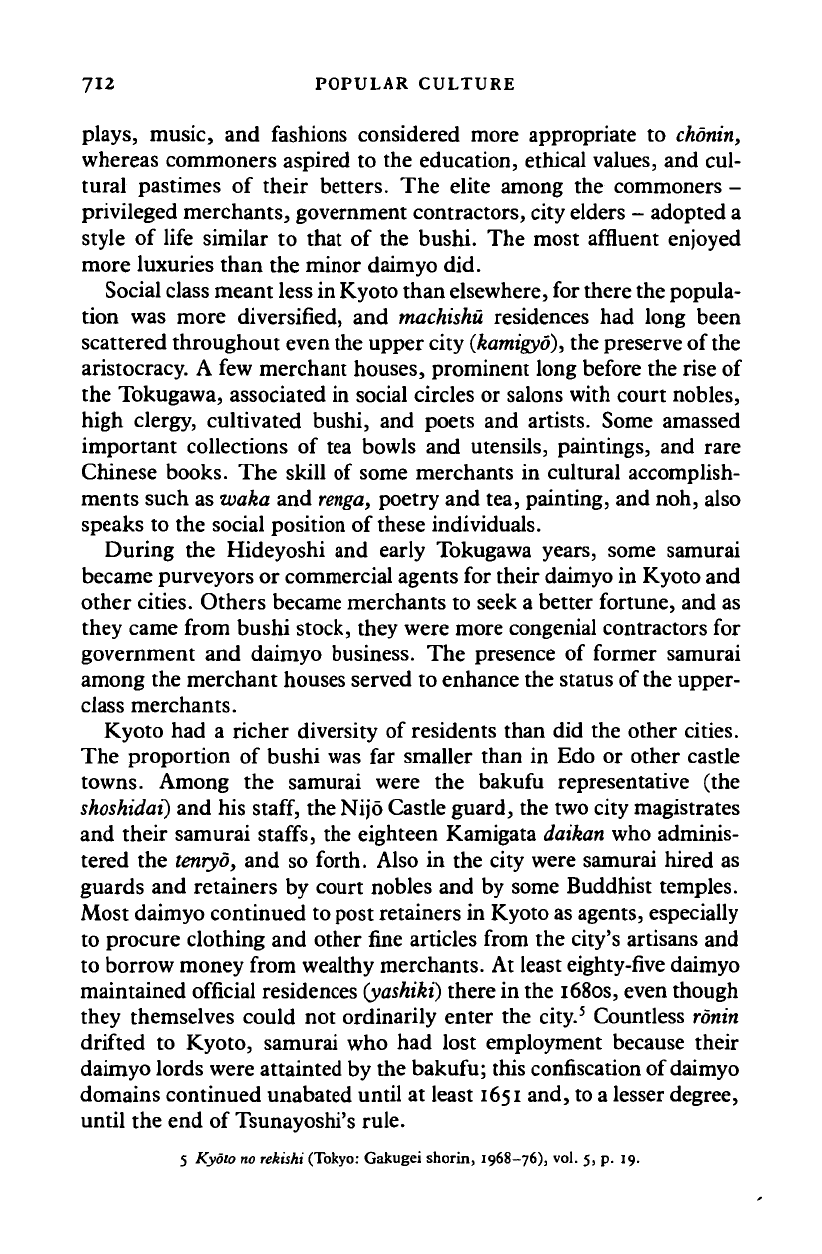
712 POPULAR CULTURE
plays,
music, and fashions considered more appropriate to chonin,
whereas commoners aspired to the education, ethical values, and cul-
tural pastimes of their betters. The elite among the commoners -
privileged merchants, government contractors, city elders - adopted a
style of life similar to that of the bushi. The most affluent enjoyed
more luxuries than the minor daimyo did.
Social class meant less in Kyoto than elsewhere, for there the popula-
tion was more diversified, and
machishu
residences had long been
scattered throughout even the upper city
(kamigyo),
the preserve of the
aristocracy. A few merchant houses, prominent long before the rise of
the Tokugawa, associated in social circles or salons with court nobles,
high clergy, cultivated bushi, and poets and artists. Some amassed
important collections of tea bowls and utensils, paintings, and rare
Chinese books. The skill of some merchants in cultural accomplish-
ments such as waka and
renga,
poetry and tea, painting, and noh, also
speaks to the social position of these individuals.
During the Hideyoshi and early Tokugawa years, some samurai
became purveyors or commercial agents for their daimyo in Kyoto and
other cities. Others became merchants to seek a better fortune, and as
they came from bushi stock, they were more congenial contractors for
government and daimyo business. The presence of former samurai
among the merchant houses served to enhance the status of
the
upper-
class merchants.
Kyoto had a richer diversity of residents than did the other cities.
The proportion of bushi was far smaller than in Edo or other castle
towns. Among the samurai were the bakufu representative (the
shoshidai)
and his
staff,
the Nijo Castle guard, the two city magistrates
and their samurai staffs, the eighteen Kamigata
daikan
who adminis-
tered the
tenryo,
and so forth. Also in the city were samurai hired as
guards and retainers by court nobles and by some Buddhist temples.
Most daimyo continued to post retainers in Kyoto as agents, especially
to procure clothing and other fine articles from the city's artisans and
to borrow money from wealthy merchants. At least eighty-five daimyo
maintained official residences
(yashikt)
there in the 1680s, even though
they themselves could not ordinarily enter the city.
5
Countless
ronin
drifted to Kyoto, samurai who had lost employment because their
daimyo lords were attainted by the bakufu; this confiscation of daimyo
domains continued unabated until at least
1651
and, to a lesser degree,
until the end of Tsunayoshi's rule.
5 Kyoto no rekishi (Tokyo: Gakugei shorin, 1968-76), vol. 5, p. 19.
Cambridge Histories Online © Cambridge University Press, 2008
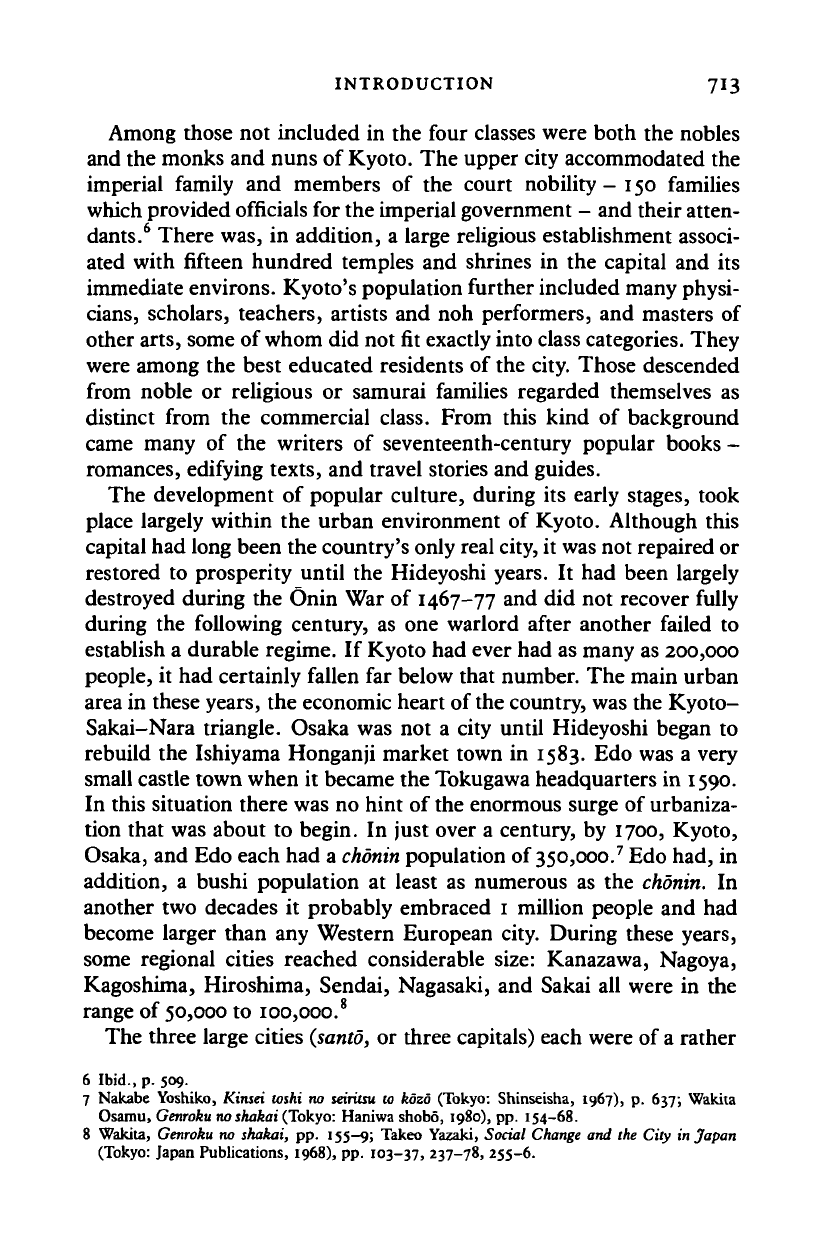
INTRODUCTION 713
Among those not included in the four classes were both the nobles
and the monks and nuns of
Kyoto.
The upper city accommodated the
imperial family and members of the court nobility- 150 families
which provided officials for the imperial government - and their atten-
dants.
6
There was, in addition, a large religious establishment associ-
ated with fifteen hundred temples and shrines in the capital and its
immediate environs. Kyoto's population further included many physi-
cians,
scholars, teachers, artists and noh performers, and masters of
other arts, some of whom did not fit exactly into class categories. They
were among the best educated residents of the city. Those descended
from noble or religious or samurai families regarded themselves as
distinct from the commercial class. From this kind of background
came many of the writers of seventeenth-century popular books -
romances, edifying texts, and travel stories and guides.
The development of popular culture, during its early stages, took
place largely within the urban environment of Kyoto. Although this
capital had long been the country's only real city, it was not repaired or
restored to prosperity until the Hideyoshi years. It had been largely
destroyed during the Onin War of 1467-77 and did not recover fully
during the following century, as one warlord after another failed to
establish a durable regime. If Kyoto had ever had as many as 200,000
people, it had certainly fallen far below that number. The main urban
area in these years, the economic heart of the country, was the Kyoto-
Sakai-Nara triangle. Osaka was not a city until Hideyoshi began to
rebuild the Ishiyama Honganji market town in 1583. Edo was a very
small castle town when it became the Tokugawa headquarters in 1590.
In this situation there was no hint of the enormous surge of urbaniza-
tion that was about to begin. In just over a century, by 1700, Kyoto,
Osaka, and Edo each had a
chdnin
population of
350,000.
7
Edo had, in
addition, a bushi population at least as numerous as the
chdnin.
In
another two decades it probably embraced 1 million people and had
become larger than any Western European city. During these years,
some regional cities reached considerable size: Kanazawa, Nagoya,
Kagoshima, Hiroshima, Sendai, Nagasaki, and Sakai all were in the
range of 50,000 to 100,000.
8
The three large cities
(santo,
or three capitals) each were of
a
rather
6 Ibid., p. 509.
7 Nakabe Yoshiko, Kinsei toshi no seiritsu to kozo (Tokyo: Shinseisha, 1967), p. 637; Wakita
Osamu,
Genroku no
shakai (Tokyo: Haniwa shobd, 1980), pp. 154-68.
8 Wakita, Genroku no shakai, pp. 155-9; Takeo Yazaki, Social Change and the City in Japan
(Tokyo: Japan Publications, 1968), pp. 103-37, 237-78, 255-6.
Cambridge Histories Online © Cambridge University Press, 2008
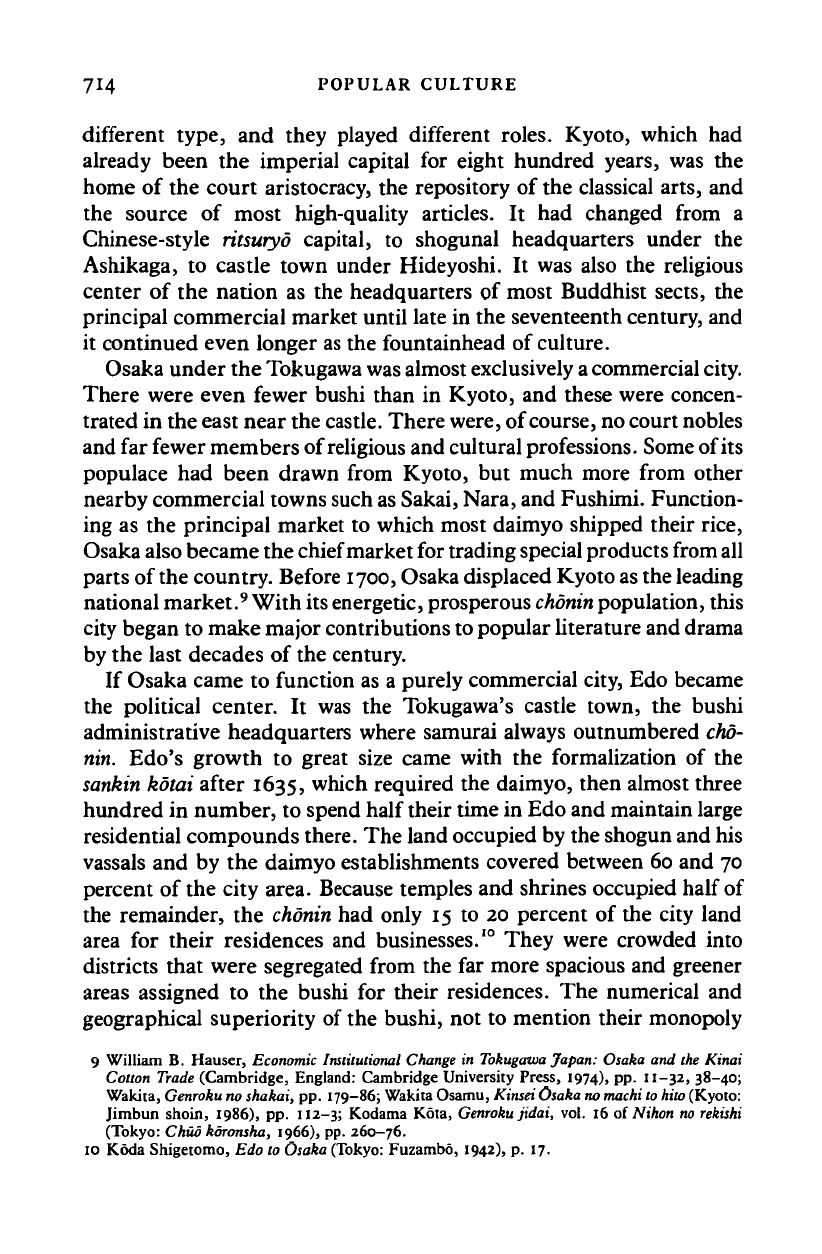
714 POPULAR CULTURE
different type, and they played different roles. Kyoto, which had
already been the imperial capital for eight hundred years, was the
home of the court aristocracy, the repository of the classical arts, and
the source of most high-quality articles. It had changed from a
Chinese-style rilsuryo capital, to shogunal headquarters under the
Ashikaga, to castle town under Hideyoshi. It was also the religious
center of the nation as the headquarters of most Buddhist sects, the
principal commercial market until late in the seventeenth century, and
it continued even longer as the fountainhead of culture.
Osaka under the Tokugawa was almost exclusively
a
commercial city.
There were even fewer bushi than in Kyoto, and these were concen-
trated in the east near the
castle.
There were, of course, no court nobles
and far fewer members of religious and cultural professions.
Some
of its
populace had been drawn from Kyoto, but much more from other
nearby commercial towns such as Sakai, Nara, and Fushimi. Function-
ing as the principal market to which most daimyo shipped their rice,
Osaka also became the chief market for trading special products from
all
parts of the country. Before 1700, Osaka displaced Kyoto
as
the leading
national market.
9
With
its
energetic,
prosperous
chonin
population, this
city began to make major contributions to popular literature and drama
by the last decades of the century.
If Osaka came to function as a purely commercial city, Edo became
the political center. It was the Tokugawa's castle town, the bushi
administrative headquarters where samurai always outnumbered
cho-
nin.
Edo's growth to great size came with the formalization of the
sankin
kotai after 1635, which required the daimyo, then almost three
hundred in number, to spend half their time in Edo and maintain large
residential compounds there. The land occupied by the shogun and his
vassals and by the daimyo establishments covered between 60 and 70
percent of the city area. Because temples and shrines occupied
hah
0
of
the remainder, the
chonin
had only 15 to 20 percent of the city land
area for their residences and businesses.
10
They were crowded into
districts that were segregated from the far more spacious and greener
areas assigned to the bushi for their residences. The numerical and
geographical superiority of the bushi, not to mention their monopoly
9 William B. Hauser, Economic Institutional Change in
Tokugawa
Japan: Osaka and the Kinai
Cotton Trade (Cambridge, England: Cambridge University Press, 1974), pp. 11-32, 38-40;
Wakita, Genroku no shakai, pp. 179-86; Wakita Osamu, Kinsei Osaka
no machi to hito
(Kyoto:
Jimbun shoin, 1986), pp. 112-3; Kodama Kota,
Genroku
jidai, vol. 16 of Nihon no
rekishi
(Tokyo: Chud koronsha, 1966), pp. 260-76.
10 Koda Shigetomo, Edo to Osaka (Tokyo: Fuzambo, 1942), p. 17.
Cambridge Histories Online © Cambridge University Press, 2008
